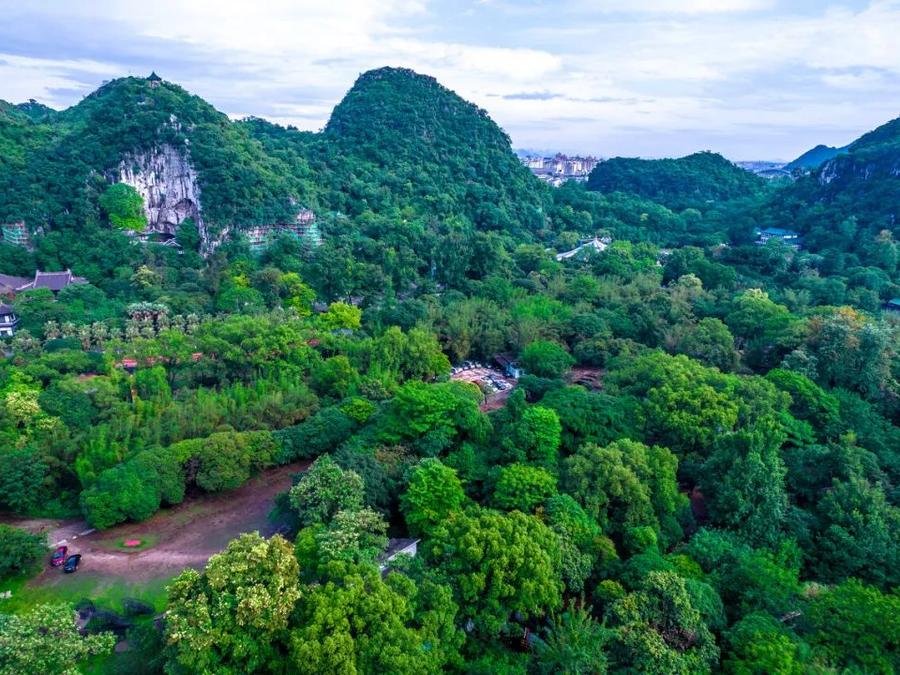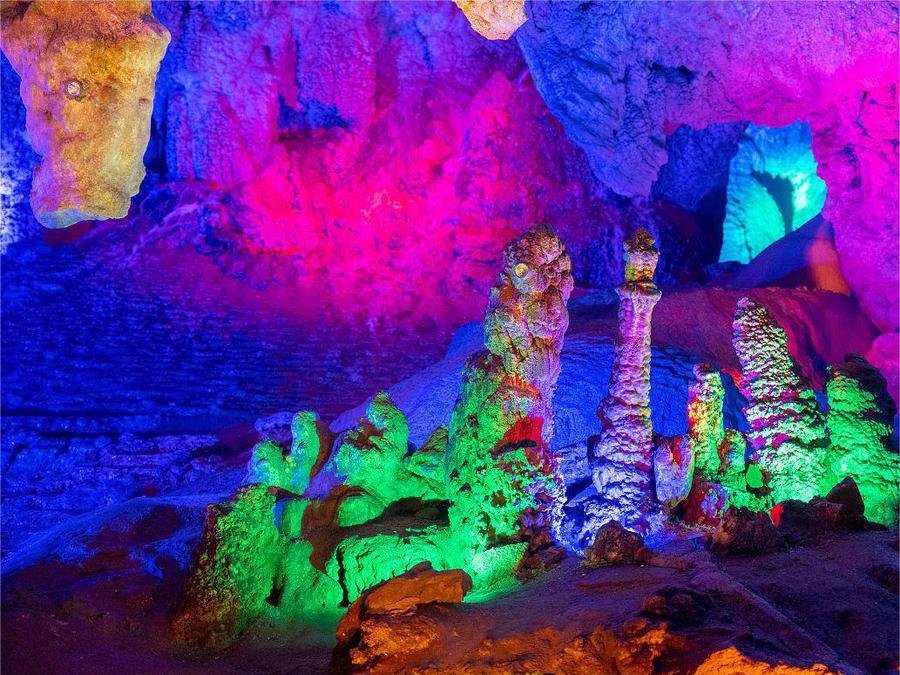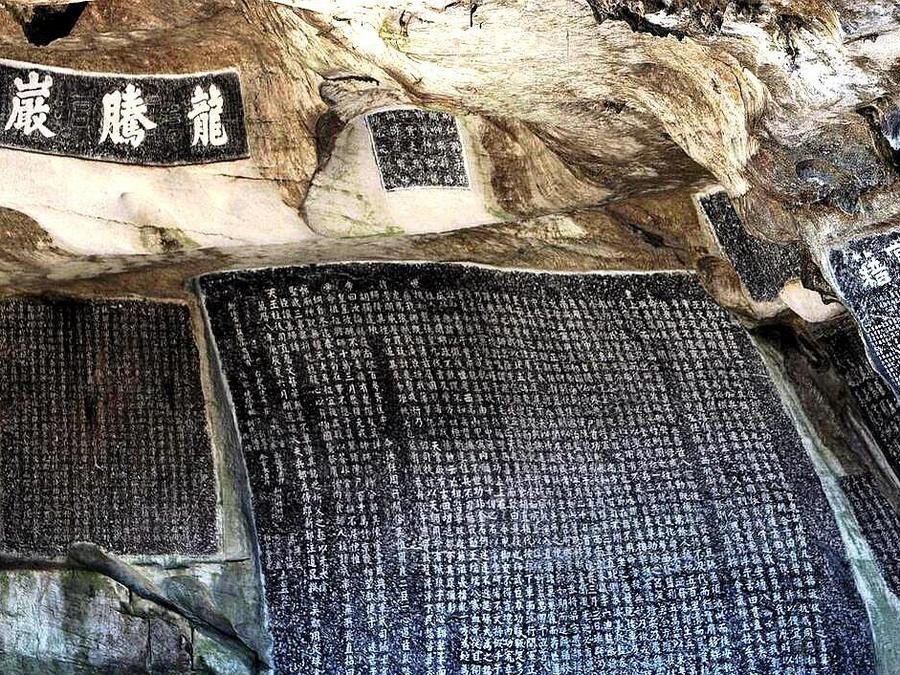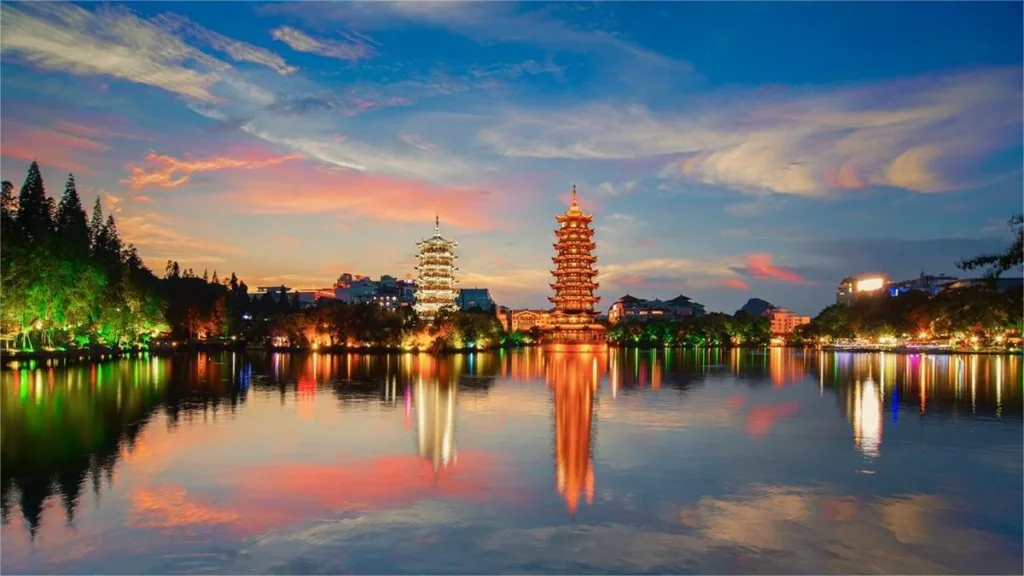Seven Star Park (七星公园, Qixing Park), located on the east bank of the Li River, covers an expansive area of 137.4 hectares. As Guilin’s largest and oldest comprehensive park, it boasts a rich array of natural and cultural attractions, including a zoo. The park is a masterpiece among Guilin’s scenic spots, offering visitors a perfect blend of natural beauty and historical significance.
From an aerial perspective, the seven peaks within the park resemble the Big Dipper constellation. The three southern peaks, known as “Crescent Mountain,” represent the handle of the dipper, while the four northern peaks, called “Putuo Mountain,” form the bowl. Together, these seven peaks are referred to as “Seven Star Mountain,” a name that also extends to the park and the renowned Seven Star Cave.
The park’s scenic environment is both beautiful and spacious, making it a popular tourist destination since as early as the Sui and Tang dynasties. Over the centuries, Seven Star Park has welcomed numerous notable visitors, including Deng Xiaoping and Bill Clinton, who have come to admire its beauty and historical significance.
Among the park’s many attractions is the precious “Yuanyou Party Membership Stele.” According to historical records, during the Song Dynasty, Prime Minister Cai Jing, in an effort to eliminate political rivals, listed over 300 people, including Sima Guang and Su Shi, as members of the Yuanyou Party. Emperor Huizong ordered the erection of stone steles across the country to record this event. However, the following year, he decreed the destruction of all these steles. The stele at Longyin Cave in Seven Star Park is the only remaining intact example in China, serving as a testament to the political struggles of the Song Dynasty.
Table of Contents
- Basic Information
- Location and Transportation
- Highlights of Seven Star Park
- Vlog about the Seven Star Park
- Other Attractions in Guilin Urban Area
Basic Information
| Estimated Length of Tour | 2 – 3 hours |
| Ticket Price | Admission: 55 RMB Admission + Seven Star Cave: 100 RMB |
| Opening Hours | 8.00 – 18.00 |
| Telephone Number | 0086-0773-5815050 0086-0773-5814342 |
Location and Transportation
Seven Star Park is located at 1 Qixing Road, Qixing District, Guilin City, Guangxi Province, on the east bank of the Lijiang River. To get there, you can take bus 10, 11, 14, 18, 21, 24, 25, 30, 204, 206, or 207 and get off at Seven Star Park Stop (七星公园站).
Highlights of Seven Star Park
Seven Star Mountain

Seven Star Mountain is composed of four peaks from Putuo Mountain (Tianshu, Tianxuan, Tianji, and Tianquan) and three peaks from Crescent Mountain (Yuheng, Kaiyang, and Yaoguang). The elevations of these peaks are 265, 255, 248, 245, 255, 241, and 250 meters respectively, with the seven peaks almost aligned horizontally. Putuo Mountain is to the east and Crescent Mountain to the west, resembling the Big Dipper constellation in space, which is how the mountain got its name. The mountain spans an area of 51.5 hectares and is famous for its numerous and unique caves. Besides the Seven Star Cave, there are dozens of other caves like Yuanfeng, Xuanwu, Baihe Cave, Sixian Cave, and Zenggong Cave. The stone forest on Putuo Mountain stands out prominently. The bonsai garden under Camel Peak gathers the best of Guilin’s rocks and woods, exhibiting extraordinary elegance. Additionally, there are more than 500 stone carvings dating back to the Sui and Tang dynasties.
Seven Star Cave

Seven Star Cave, located within Putuo Mountain in Seven Star Park, stretches approximately 1,100 meters long, with a maximum width of 54 meters and a height of 27 meters. Originally an underground riverbed, it emerged above ground due to crustal movements, transforming into a cave. Over the ages, rainwater continuously seeped through rock crevices, dissolving limestone and forming a variety of stunning stalactites, stalagmites, stone pillars, stone curtains, and stone flowers. The cave has three levels: the upper level, remnants of the original roof; the lower level, an actively developing underground river; and the middle level, open to visitors, with a tour path of 814 meters. The temperature inside the cave remains around 20°C year-round. As early as 1,300 years ago, during the Sui and Tang dynasties, Seven Star Cave was a popular tourist destination, with over 120 inscriptions left by visitors. The great traveler Xu Xiake visited the cave twice during the Ming Dynasty, and former U.S. President Bill Clinton toured it in 1998, finding it fascinating.
Huaxiao Bridge

Huaxiao Bridge (Flower Bridge) is the oldest bridge in Guilin, originally built during the Jiaxi period of the Song Dynasty. Located at the main entrance of the park, it spans the confluence of Xiaodongjiang River and Lingjian Creek, with a total length of 135 meters. The bridge features a covered corridor with green glazed tiles on the pavilions and a robust stone structure, showcasing a rich ethnic style. Each spring and summer, the bridge is surrounded by blooming flowers, peach blossoms, and bamboo, giving it the appearance of being hidden among a sea of flowers, which is how it got its name. Before 1949, parts of the stone bridge’s piers had sunk, and the railings had collapsed. After renovations in 1965, the bridge’s total length is 134.66 meters, composed of both water and land sections. The water bridge is 6.9 meters wide with four large arches, which, when reflected in the water, resemble a full moon.
Putuo Mountain

Putuo Mountain is the main body of Seven Star Park, composed of four peaks: Tianshu, Tianxuan, Tianji, and Tianquan, located in the northwest part of Seven Star Mountain. With an elevation of 265 meters, it is named after the Bodhisattva Guanyin, to whom a temple is dedicated on the mountain. Putuo Mountain is rich in scenery, with numerous caves and pavilions. The most famous is Seven Star Cave, while the pavilions, such as Qixia Pavilion and Bixu Pavilion, are particularly unique. On the western slope of the mountain lies Yuanfeng Cave, which remains cool even during the height of summer. From here, a shaded path lined with osmanthus trees leads north to Putuo Gate, where visitors can enter and ascend the mountain. The mountain is home to many attractions, including the Putuo Stone Forest, Putuo Tower, Guanyin Cave, and Xuanwu Pavilion. At the top of Tianji Peak stands the Star Plucking Pavilion, offering panoramic views.
Camel Mountain

Camel Mountain is located behind Putuo Mountain and resembles a camel squatting on the ground. Due to its likeness to an ancient wine jug, it is also called Jug Mountain or Wine Jug Mountain. In the late Ming Dynasty, a renowned scholar from Jiangnan, Lei Jiuren, lived here in seclusion and planted numerous peach trees. Every spring, the blooming peach blossoms cover the mountain in a red haze, as if draping it in a crimson glow, creating an exceptionally beautiful scene. In July 1998, after holding an environmental symposium with Chinese locals at the Bonsai Art Garden next to Camel Mountain, U.S. President Bill Clinton delivered an environmental speech on the lawn in front of the mountain. He humorously referred to a Guilin folding fan he was holding as an “energy-saving air conditioner.”
Guihai Stele Forest

The Guihai Stele Forest pavilion houses thousands of important stone inscription rubbings collected from other mountains and caves in Guilin, all of which are rare treasures. Among them is the “Map of Jingjiang Prefecture,” a rubbing from Parrot Mountain in northern Guilin, which is one of the two oldest ancient stone maps in China and the largest stone map in the country. This map employs landscape-style symbols, representing a significant innovation in the history of map design. Other notable inscriptions include Han Yungeng’s “Ode to the Pacification of the Barbarians” and “Stele of the Shun Temple” from the Tang Dynasty, which recount the Tang court’s suppression of the western chieftain Pan Changan; Kong Yanzhi’s “Record of the Burial of the Yi Rebel Leader” and Yu Jing’s “Stele of the Song Dynasty’s Pacification of the Barbarians” from the Song Dynasty, detailing the Song court’s subjugation of Ou Xifan in Yizhou; and the “Record of the Newly Built Rewards Warehouse” by Chen Mishou and “Meritorious Deeds in Resisting the Yuan” by Li Zengbo from the Southern Song Dynasty, describing the Yuan army’s attacks on Yunnan, Guangxi, and Hunan, and the Song army’s defensive efforts.





